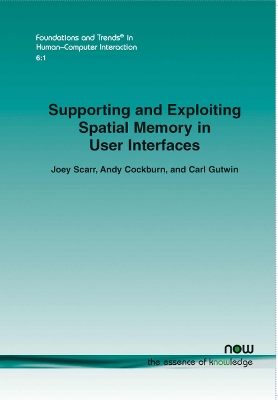Foundations and Trends (R) in Human-Computer Interaction
2 total works
Supporting and Exploiting Spatial Memory in User Interfaces
by Joey Scarr, Andy Cockburn, and Carl Gutwin
Published 5 December 2013
Spatial memory is an important facet of human cognition - it allows users to learn the locations of items over time and retrieve them with little effort. In human-computer interfaces, a strong knowledge of the spatial location of controls can enable a user to interact fluidly and efficiently, without needing to visually search for relevant controls. Computer interfaces should therefore be designed to provide support for developing the user's spatial memory, and they should allow the user to exploit it for rapid interaction whenever possible. However, existing systems offer varying support for spatial memory.
Many modern interfaces break the user's ability to remember spatial locations, by moving or re-arranging items; others leave spatial memory underutilised, requiring slow sequences of mechanical actions to select items rather than exploiting users' strong ability to index items and controls by their on-screen locations.
Supporting and Exploiting Spatial Memory in User Interfaces highlights the importance of designing for spatial memory in HCI. It summarizes empirical results on spatial memory from both the psychology and HCI domains, identifying a set of observable properties of spatial memory that can be used to inform design. It also analyses existing interfaces in the HCI literature that support or disrupt spatial memory, including space-multiplexed displays for command and navigation interfaces, different techniques for dealing with large spatial data sets, and the effects of spatial distortion.
This book provides strong evidence that spatial knowledge of controls and data enables rapid interaction and information retrieval, and allows users to focus more of their cognitive resources on the task at hand, rather than on the interface. It is aimed at user interface designers, as well as other HCI researchers interested in spatial memory.
Useful guidelines for designers are identified throughout the book, which provide clear advice on how and when to design with spatial memory in mind. Similarly, the concluding summary of the area, as well as methodological cautions and directions for future research provide an excellent resource for scientists interested in the importance of spatial memory in user interfaces.
Many modern interfaces break the user's ability to remember spatial locations, by moving or re-arranging items; others leave spatial memory underutilised, requiring slow sequences of mechanical actions to select items rather than exploiting users' strong ability to index items and controls by their on-screen locations.
Supporting and Exploiting Spatial Memory in User Interfaces highlights the importance of designing for spatial memory in HCI. It summarizes empirical results on spatial memory from both the psychology and HCI domains, identifying a set of observable properties of spatial memory that can be used to inform design. It also analyses existing interfaces in the HCI literature that support or disrupt spatial memory, including space-multiplexed displays for command and navigation interfaces, different techniques for dealing with large spatial data sets, and the effects of spatial distortion.
This book provides strong evidence that spatial knowledge of controls and data enables rapid interaction and information retrieval, and allows users to focus more of their cognitive resources on the task at hand, rather than on the interface. It is aimed at user interface designers, as well as other HCI researchers interested in spatial memory.
Useful guidelines for designers are identified throughout the book, which provide clear advice on how and when to design with spatial memory in mind. Similarly, the concluding summary of the area, as well as methodological cautions and directions for future research provide an excellent resource for scientists interested in the importance of spatial memory in user interfaces.
Design Framework for Interactive Highlighting Techniques
by Joshua Leung and Andy Cockburn
Published 24 November 2021
Highlighting techniques are a diverse class of visual communication techniques that make users aware of salient information in a timely manner. Any visual effect can potentially be used and manipulated to create highlighting effects given the right context, which makes the design space for highlighting techniques broad and rich. Although highlighting techniques are a common and important part of user interfaces, there is a lack of understanding about how to select, apply, andcontrol their effects to achieve the best results. This monograph lays the foundations for addressing this knowledge gap and proposes a new framework.The authors review the current understanding of highlighting techniques, their effects, and prior methods of measuring those effects. They also review underlying human factors that affect how users interact with highlighting techniques. To address the knowledge gap, they present a new structured design framework – Parametric Control and Construction of Highlights (PCCH) – for describing highlighting techniques in a concise and objective way, using parameters to accurately specify highlighting technique configurations.

